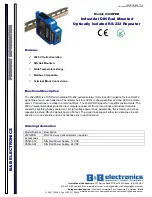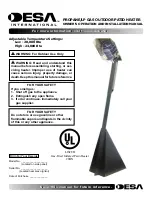
IO-123163 Effective 01-14-2016
9
Fig 11-3.
11A. Single Stage Cooling
During cooling mode operation, indoor blower wire “G” will energize
a time delay relay located on the control board inside the air handler.
After a short time delay period, the time delay relay will apply 120VAC
to the motor via the “MTR“ terminal. (See Schematic Fig 20-1.) Fan
time delay periods are 30 seconds ON delay and 120 seconds OFF
delay.
The Y wire from the thermostat is not connected at the air
handler. This wire goes directly to the outdoor unit 24 volt wiring
to turn on the outdoor condensing unit when a call for cooling
takes place. The 24 volt common for the outdoor unit circuitry
is connected at the air handler brown wire. (See Fig 11-1.)
The hydronic heater low voltage wiring terminal “W” is wired directly
from the thermostat to the air handler. The indoor blower, on a call for
heat, will ON delay for a period of 5 seconds. When the call for heat
has been satisfied, the indoor blower will have an OFF delay time
period of 60 seconds.
Operating CFM based upon each speed tap number is shown on
the electrical wiring diagram of the unit. Final air volume adjustments
should be made by referencing total external static pressure (Table
11A-1).
Table 11A-1.
120VAC 24VAC (Fig 11-3).
Transformer
11B. Heating
The unit ships with a micro-processor based board
which controls the electrical functioning of the unit. An
inspection of the controls is recommended prior to startup.
Fig.11-C1 provides a schematic of the control board present in the
unit. The unit ships from the factory with the aquastat jumper in the
OFF position (right two pins) and the heating selector in the HW
position (right two pins). If an aquastat is used in the application; the
jumper should be changed to the ON position (left two pins).
Note: Terminals T and N located on the top right side of the board are
not intended for field use and should be left disconnected.
11C. Jumper Placement
The aquastat (AQ) jumper must be in the
OFF position at all times, except for when
an aquastat is used. If the jumper is moved
to the ON position without installing an aquastat, the blower
will not be energized.
CAUTION
!
11D. Pump/Valve/Boiler Wiring
Fig.11C-3
The freeze protection sensor is connected to the “FP” and “R“
terminals. This sensor is normally open and will close when the
sensor detects a temperature of less than 40ºF. The pump will
operate and stay ON for a minimum of 30 seconds.
The board has a built-in timer which circulates hot water 6 times a
day for 60 seconds to prevent the hydronic coil from freezing.
11E. Freeze Protection Sensor Wiring
On units shipped from the factory with a pump installed (Fig 11C-3),
the pump will be energized on a call for heat.
On units that were shipped without factory installed pumps, two
black wires should be connected to the terminals marked “BOILER”
T T (see Fig 11C-1). In applications where a boiler provides the hot
water supply, these wires should be connected to the boiler control
wiring. Terminals “BOILER” T T are normally open dry contacts.
In applications where a valve or pump is used to regulate the
hot water supply, the two black wires located on the “BOILER” T
T terminals should be removed and placed on the two terminals
marked “VALVE”. These wires should be connected to a 24V valve
or pump relay according to local requirements and instructions of the
valve or relay manufacturer.
On a call for heat, 24V will be sent to the field-installed valve or pump
relay, the valve will open or pump relay will close contacts allowing
the pump to run. Water will circulate through the water (hydronic) coil
for 60 seconds prior to energizing the blower. After the thermostat is
satisfied, the blower will continue to stay energized for a minimum of
30 seconds. The additional blower run time helps maximize heating
efficiency.
The air handler uses a 120VAC
to 24VAC step-down transformer.
Fig.11-C1
BLOWER DATA
UNIT
MODEL
RPM AMP VOLT
HP
CFM VS. STATIC PRESSURE
0.1
0.2
0.3
0.4
0.5
GFS/T
18-24
1625
7.0
120
1/2
680
620
560
490
430
800
730
670
600
530
GFS/T
30-36
1/2 (X2)
1150
1070
990
900
800
1270
1180
1100
1000
900
Add .05 static when enclosure and/or ceiling panel are used. GFS/T 30 and 36 have two motors and four blowers.


































